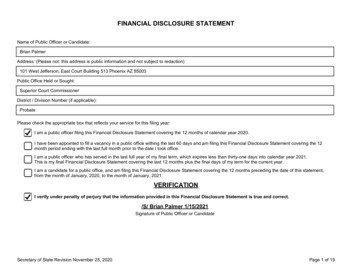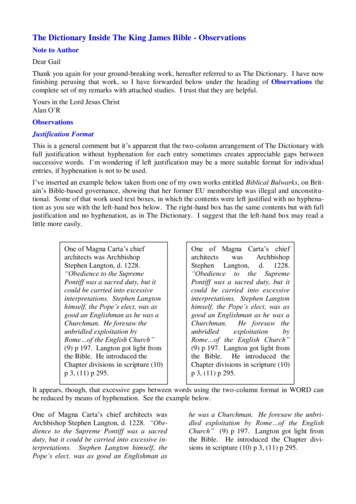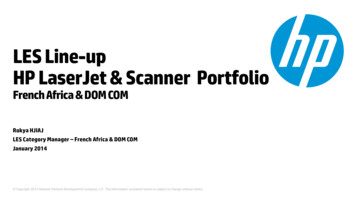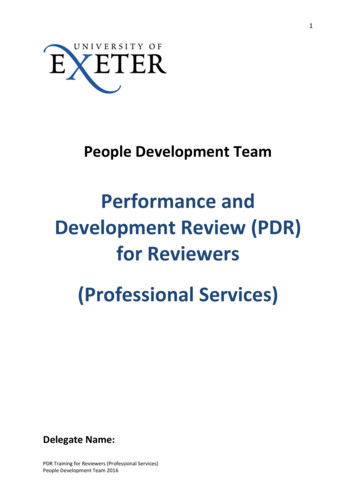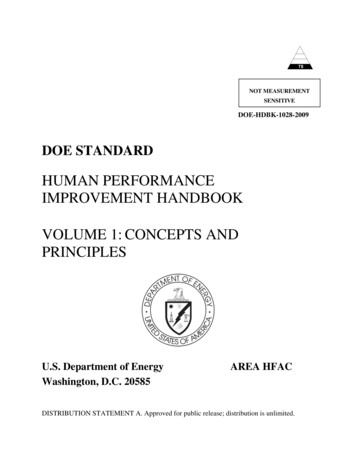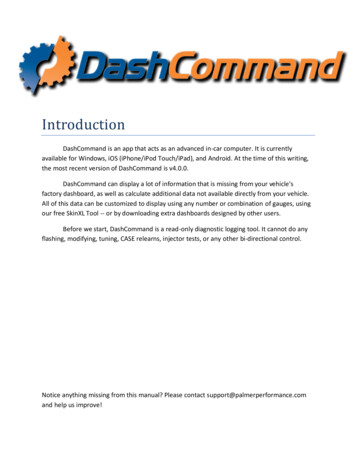
Transcription
IntroductionDashCommand is an app that acts as an advanced in-car computer. It is currentlyavailable for Windows, iOS (iPhone/iPod Touch/iPad), and Android. At the time of this writing,the most recent version of DashCommand is v4.0.0.DashCommand can display a lot of information that is missing from your vehicle'sfactory dashboard, as well as calculate additional data not available directly from your vehicle.All of this data can be customized to display using any number or combination of gauges, usingour free SkinXL Tool -- or by downloading extra dashboards designed by other users.Before we start, DashCommand is a read-only diagnostic logging tool. It cannot do anyflashing, modifying, tuning, CASE relearns, injector tests, or any other bi-directional control.Notice anything missing from this manual? Please contact support@palmerperformance.comand help us improve!
Main MenuThis is the first screen you will see when you start DashCommand, it allows you toaccess all of the different features DashCommand has to offer. At the top the menu will showyour currently selected vehicle, and the current date/time. The date changes to a statusmessage when the software is busy connecting, or when doing any other lengthy operations.The connection button indicates the current connection status. It is orange when you are notconnected to a vehicle, yellow while a connection is in progress, or green when you havesuccessfully connected.The available sub-screens are: ConnectionRace TrackDashboardsGaugesPerformanceInclinometerSkid PadDiagnosticsVehicle ManagerAdvance SettingsConsoleData GridSettings
ConnectionThis main menu option attempts to open a connection to the vehicle. For most users,you'll want to have already selected a vehicle from the Vehicle Manager before you try toconnect. Also, you will need to make sure you have the correct Interface Type selected inSettings. You can see that it is opening the OBD-II connection from the text in the status bar atthe top.If the connection was successful, the orange circle in the connection button will turngreen and say “Connected” -- indicating you are currently connected. If this circle turns orangeat any point, the connection to the vehicle has been lost.
Race TrackThe Race Track uses your phone's GPS to map your course around any track, anywhere.If you have cell data available, it will download the Google Maps image to use as thebackground. It also color codes your path. Green is acceleration, yellow is no acceleration /coasting, and red is braking. There is a Skid Pad visible at the bottom, as well as someinformation such as GPS calculated speed, GPS accuracy, and distance travelled as calculated byGPS. There is no limit to how long, or how far, the Race Track will map. It will never erase yourprevious course (unless you tell it to, by selecting Zero from the menu), and will automaticallyzoom out if you leave the screen area. It is only as accurate as the GPS in your device, somephones may be more accurate than others.
DashboardsThe Dashboards screen is the place you will likely spend most of your time inDashCommand. This is where you can view live data through a number of gauges called SkinSets. A Skin Set is a collection of dashboards, each dashboard defining exactly 1 screen worth ofgauges. You can change to a different skin set at any time by going to Settings.The default Tuxedo skin is a very complete, detailed skin showing nearly every gaugepossibly available from your vehicle. Not all vehicles will support all PIDs, so some PIDs may beunable to be displayed. Here is a brief overview of each: It has a Performance dashboard for RPM, speed, power, torque, and boost.It also has a Fuel Economy page showing your instant and average MPG, as well as anMPG graph over the last 3 hours. It has gauges for fuel level remaining, and distance toempty. You can press the Fuel Economy tab a second time to gain access to a sub menuwith a reset button.There is a Trip Stats page showing a very large number of trip stats. Everything frommin/max engine speed, to driving time, and even calculated CO2 emissions and fuelcosts. Again, you can press this tab to reveal additional sub-trips, or a reset button.The Engine dashboard shows various engine health gauges. MAP, MAF, intake temp,timing advance, and fuel trims are just a few. You can touch the Engine tab again to getto the second Engine dashboard.The final dashboard, Fill-up, is where you can enter fuel cost, and the number of gallonsyou added to the tank. This screen is completely optional, and is only used to helpcalibrate the fuel economy PIDs a little more. IMPORTANT NOTE: If you are notmonitoring with DashCommand for the ENTIRE tank, DO NOT USE THIS SCREEN. Usingthis screen for an incomplete monitoring session will falsely, and drastically, skew youreconomy numbers.Many gauges are able to be touched and toggled to a different gauge, other gauges totouched to cycle between the current, min, and max values for that gauge. Touching the gaugein the area of the numbers displayed will switch to the alternate display.
GaugesGauges is a way to add an easy custom gauge to be viewed on a screen.When you open Gauges you will see a screen like the one on the left. To edit, you simply touch thescreen and an edit button will drop on the screen like the center picture. After pressing the edit buttonat the top, you will open the edit options like the right image.Once the edit menu is open, you can touch a gauge to edit it or move it, or you can click the bottombuttons to add another page to put gauges on or add another gauge.To edit a gauge, touch a gauge while the edit bar is at the bottom and you will see it open a menu likethe one pictured on the left. If you click on “Edit Gauge” you will see the gauge edit menu like thecenter picture. From there you select your Style and Type, then set the PIDs you want to be used. Makesure you set all of the PIDs for Needle, LCD, and Marker to be the ones you want. You can also click abox inside of the Marker PID to remove the marker and not have one displayed. Now you have yourPID, you need to set the limits (right picture). Low Limit is the lowest number on the gauge (can be anegative number), High Limit is the largest number on the gauge. Multiplier is used to make thedisplayed number smaller, for example on RPM you would see 1000,2000,3000, etc displayed, but if youset the multiplier to ‘1000’, it would show 1,2,3, etc. Do not change you High Limit with the multiplier,we will do it for you automatically.
PerformancePerformance is a quarter mile and speed timer performance page. With this page you can record yourvehicles acceleration performance. On the bottom left you have a toggle to change from ¼ mile to 0-60.On the ¼ mile timer, you have the optional start button in red, you can press that to start the stage lightcountdown so you can get a reaction time with your results, otherwise you just start moving to start therecording. Stop and start again to record a new time. DashCommand will fill the bars of each incrementas you cross 60 feet, 330 feet, 1/8 mile, etc. (You can stop after a 1/8 mile run and see results, you don’thave to go a full ¼ mile. You can get your results break down by pressing the green results button.The 0-60 timer will track your 0-60 time by default. You simply start moving and the timer starts, whenyou reach 60 it will show your time. It is not only a 0-60 timer, you can hit the edit button and change itto any start time and stop time. The time will start when you reach your starting speed and stop at yourstop speed. To try again, just slow down below your minimum speed and start again, no buttons topress, it is fully automatic. The reset button will clear your Fastest and Last ET numbers.
Skid PadThis Skid Pad uses the accelerometer built into the phone to calculate G-Forces in anygiven direction. It puts a dot at the corresponding point for every reading. DashCommand alsosaves Skid Pad data even while you are in a different screen, and draws it all onto the Skid Padonce you return. There is no limit to the amount of time you can monitor with the Skid Pad, andit will not ever erase your previous points. You can manually reset the Skid Pad points from themenu.To avoid users having to perform a manual calibration, the Skid Pad automaticallycalibrates itself to your phone's orientation when you launch DashCommand. If you startedDashCommand before you had the phone situated in your mount, go to the menu and selectZero to recalibrate. Also, because of the orientation sensitive nature of this feature, theorientation is locked to the current orientation while you are viewing the Skid Pad.
InclinometerThis simple feature uses the accelerometer in your phone to calculate your currentincline for you off-road fans. There are 2 different views available, and a Toggle View option inthe menu switches between them. Just like the Skid Pad, you will need to Zero this screen if youstarted DashCommand while holding the phone.
DiagnosticsThe Diagnostics page allows you to read and clear trouble codes, and view the currentemission monitor status. Notice that clearing the trouble codes will also clear all emissionsmonitor data as is legally required. For a few select vehicles, you can only clear the troublecodes with the engine off (key on, engine not running). The Diagnostics view will give a shortcode description for all codes that are OBD-II standardized. Manufacturer-specific codes canstill be read, but they will not have a description. Each monitor will be reported aspassed/complete, failed/not complete, or not supported. A passed monitor is indicated by agreen checkmark, a failed monitor by a red !, and an unsupported monitor by a yellow circle.
Vehicle ManagerThe Vehicle Manager is one of the first places you will visit in DashCommand. Thiscreates and manages your list of vehicles. Data logs are stored according to the vehicle youhave currently selected, as well as data such as the fuel economy history and trip stats.Supported PID lists and vehicle protocol are also saved. You can also revalidate the PIDs fromthe Vehicle Manager, which can (in certain cases) get you some extra PIDs. The PID validationwill ask the vehicle for supported PIDs again, this may help if there was some sort of error inyour first connection. You should not need to validate the PIDs unless Palmer PerformanceSupport has instructed you to do so. However, it will not hurt anything to try this on your own.You should create a new vehicle for each new physical vehicle you connect to. Even 2vehicles of the same model can have different PID sets. For iPhone, press the button near thetop to add a vehicle, or on Android press menu and select Add Vehicle. Tap on each field toenter the information about your vehicle, you can edit these later if you need to. IfDashCommand has a package of enhanced PIDs for your vehicle, then you will need to makesure the year/make/model/type are all correct. We recommend using the predefined valueswhen possible. If your vehicle does not appear in the predefined values, then there are noenhanced PIDs available for your vehicle. Use the ‘other’ field in this case, or leave it blank.You’ll also want to fill in engine displacement, fuel type, and fuel tank size -- your vehicleowner’s manual will usually have this information. Only fill in vehicle settings if you are certainthat you have the correct values. Anything you are unsure about just leave blank. If you enteran incorrect value it will skew the data calculations. Leave all "PID" Settings blank, unless toldby Support to fill these in. Certain vehicle settings are not applied until the next time youconnect to the vehicle. If you are already connected, you will want to reconnect after changingvehicle settings.
Advanced SettingsFuel Tank Capacity – Fuel tank capacity is needed for the fuel level, distance to empty, and timeto empty. The vehicle owners manual is a good source for this number.Brake Specific Fuel Consumption – BSFC is the amount of fuel consumed to make onehorsepower for one hour. This setting is directly related to the horsepower and torque values.Default is .44 if left blank. We suggest .40-.50 for naturally aspirated engines, .50-.60 for forcedinduction engines, and .30-.40 for turbo diesel engines.Volumetric Efficiency – Volumetric efficiency is needed to tune the accuracy of calculatedparameters when either SAE.MAP or SAE.MAF is not available on the vehicle. A value between60 to 85 is a good starting point. If left blank we use 75.MAF PID, MAP PID, Lambda PID – These are used to enter in aftermarket sensors to thedashboard. DO NOT enter anything here if you are not using an aftermarket sensor. Anexample entry for the Lambda PID would be AUX.PLX.LAMBDA 0 .Tire Size Specification – Here you enter in your tire size from your vehicle, this can be found onthe sidewall of your tire. This is used to calculate the gear selection page. An example entry fora tire size would be 255/60R17 .Final Drive Ratios – This value is used for the gear calculations. First you will need to enteryour axle ratio, which is your drive ratio/gear ratio/etc. An example would be 3.73 ratio. Youthen need to enter your transmission ratios for each forward gear, you may be able to find thisinformation in your owners manual.Additional Weight – This is the sum of the weight of the driver, any passengers, and thecontents of the trunk. Note: the weight of the fuel is calculated automatically.Frontal Area – This is the frontal area of your vehicle, most likely you will have to search onlineto find the value for this on your vehicle. It is not a required entry so you do not have to enteranything.Maximum Engine Speed – This value is used for the gear calculations. Set this value to engineredline.Minimum Engine Speed – This value is used for the gear calculations. Set this value to theminimum allowed speed in gear of the engine.
Shift Point – This value is used for the gear calculations. Set this value to the most economicalshift RPM.Speed Correction – This value is used to correct your vehicle speed on the dashboard display. Itis a multiplier, so 1.0 is no change.
ConsoleThe Console shows debugging information and may also have extra details about afailed connection. You should not need to touch anything in the Console unless instructed to doso by Palmer Performance.
Data GridThe Data Grid view is where some of you advanced data logging power-users might liketo be. While you can data log from the Dashboards screen, only the data on the currentdashboard (not the current Skin Set) will be saved. If you switch dashboards in the middle of adata logging session, the data will change to the new dashboard PID set. The Data Logging viewallows you to exactly control which PIDs are being monitored or recorded. You can also seewhich PIDs are supported by your vehicle, by selecting Add PID and looking for SAE.XXX PIDswith a green checkmark. CALC.XXX PIDs are always shown as supported, and are calculated byDashCommand. Notice that Persistent PIDs (see Settings for more information) are monitoredwhile in the Data Logging view, and will still be included in any log files you create.
SettingsThe final chapter of this manual, the Settings screen. While you will spend the least time inSettings, it is the largest section of this manual. We'll go over each sub-section and give moreinformation on what it is, and what it does.
Settings - GeneralStart in DashboardsThis setting, when enabled, will have DashCommand go straight to the Dashboards screen afterlaunching.Show Status BarThis will turn on or off DashCommand's built-in status bar. This bar shows the clock, connectionstatus, and current data logging status.Fullscreen ModeFullscreen mode is where DashCommand will use the entire screen of your device. When on, itwill hide the iOS/Android status bar to give more screen area to DashCommand.Enable Demo modeThis will have many gauges sweep through some demo values while you are not connected to avehicle. These numbers are completely fake, and are not based on any real vehicle. You should notexpect to see numbers even remotely similar to these while using a real vehicle.Loop playbackWhen turned on, this will loop your data log when it reaches the end, instead of ending playbackand returning to normal data monitoring.
Settings - DashboardsSelected DashboardTapping this option allows you to select a different dashboard Skin Set. It shows a list of everySkin Set currently installed on your phone. You can also delete dashboards from this screen, by longpressing the dashboard you wish to remove.Download from DashXL.netThis is where you can download extra dashboard skin sets. You can view the list of skinsuploaded by other users starting with the most recent, or search for something specific if you'd like.Visit DashXL.netThis opens DashXL.net in your device's browser.
Settings - ConnectionAuto connectAuto connect will attempt to connect to your vehicle immediately upon opening DashCommand.This happens after loading and initializing DashCommand and the Vehicle Settings, but before the Startin Dashboards setting (if turned on).OBD-II Interface TypeThis is the type of interface you are using. Available interfaces types are ELM, InnovateMotorsports, or GoPoint Technology (iPhone only). You can also opt to view compatible hardware withyour device's web browser. If you are unsure what type of interface you have, select ELM as a startingdefault.OBD-II Data PortThis is the port used to connect to your interface. Most users will leave this set to AUTO, whereit will automatically search for the most common interfaces such as the Kiwi WiFi, OBDLink WiFi,OBDKey WLAN, and others. If you have an interface not specifically tested with DashCommand, you canstill enter a custom IP address to connect to (which should be available from your hardwaremanufacturer). This setting only affects WiFi interfaces.Aux Input TypeThe Aux input type is used to determine what (if any) auxiliary input sensors you are using.Most users will never use this setting, and should leave it set to None. If you are having troubleconnecting to your vehicle, changing this setting WILL NOT increase your chances to connect throughthe OBD-II port.Aux Input OnlySet this setting to connect only to auxiliary input sensors. This will make DashCommandcompletely ignore the OBD-II port -- even if one is available to connect to. Turning this on will stop alldata from the OBD-II port. Again, it WILL NOT increase your chances of connecting.
Settings - SetupDate & TimeHere you can configure the date and time formats used in the Trip stats dashboard in thedefault Tuxedo skin.CurrencyThis setting will change the currency symbol displayed by the Tuxedo skin. Changing this settingwill only change the symbol, it will not convert between different currencies.UnitsThe Units settings will change the way the CALC PIDs and the Tuxedo dashboards display data.Here you can select between different English and Metric unit systems for many different types of data.
Settings - ParametersPersistent PIDsPersistent PIDs are PIDs that are monitoring the entire time DashCommand is running -regardless of which screen or dashboard is currently being viewed. If you have an older phone and arenoticing performance problems, start by turning this setting off.Notice that disabling Persistent PIDs means that DashCommand will not track fuel economydata or trip stats unless you are viewing those dashboards respectively. If you are using DashCommandmainly for its enhanced fuel economy and trip data, you may want to leave this on (or remove all but thefeatures you are wanting).
DashCommand. This is where you can view live data through a number of gauges called Skin Sets. A Skin Set is a collection of dashboards, each dashboard defining exactly 1 screen worth of gauges. You can change to a different skin set at any time by going to Settings. The default Tuxedo skin i
